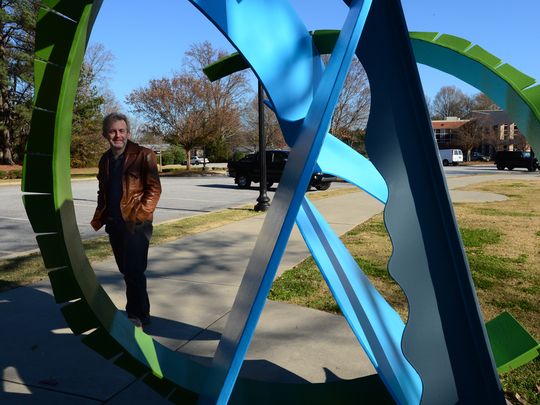First piece of new Mauldin Public Art Trail unveiled

From The Greenville News
Article by Scott Keeler; photo (above) by Heidi Heilbrunn
Just minutes before a ceremony to unveil the first piece of artwork at the Mauldin Public Art Trail Tuesday afternoon, a train rolled down the tracks across from the Mauldin Cultural Center.
While it wasn’t part of the program schedule, the train whistle blowing was a perfect way to signal the start of this particular event.
“The Depot,” a metal sculpture created by Central artist Joey Manson, officially was unveiled as the debut piece of the Art Trail. It was inspired by the theme for this inaugural year of the Art Trail, which was “Crossroads” signifying Mauldin’s geography and history.
“Mauldin’s historical borders were first drawn as a circle centered around a train depot. Highways now encircle a city that was once a crossroads, and the railroad still runs straight through,” Manson said. “The Depot” references and abstracts the historical and current transportation paths and symbolizes the dynamic forces that surround and connect Mauldin today.”
During the application process to have artwork selected, Manson visited Mauldin and made a trip to the library. There he found a book on the history of the city and the creative juices began to flow.
Manson’s selected artwork features a blue core that resembles a turning propeller surrounded by intertwining green beams with a straight dark gray beam in the middle of it all. Manson said the gray represents the train running through the heart of the city.
“The blue part is a circle that represents the town limits of Mauldin when it was initially founded,” Manson said. “The (green) lines are an abstraction of the major highways that run through this site.
“This (blue section) being a propeller also lends itself to the airfield that was around here and the turbines. That was a big part of the industry that developed Mauldin to where it is today.”
The ceremony began with Mauldin Office of Cultural Affairs Administrator George McLeer welcoming the crowd and citing the Mauldin Cultural Council, the city’s nonprofit partner in the selection of the artwork. Mauldin Cultural Council Chairman Eddie Phillips then introduced Cultural Council members in attendance and thanked everyone for coming.
“We’re very delighted so many of you took time off to come and participate in this today,” Phillips said. “This is the beginning of something great.”
Mayor Dennis Raines also spoke, praising the partnership the city enjoys with Cultural Council, before Manson cut the ribbon off the sculpture.
During his time in Mauldin, McLeer has searched for ways to display more public artwork. The Art Trail starts on the perimeter of the outdoor amphitheater behind the Cultural Center and curls around toward the front connecting with the Veterans Walk. The original plans for the Arts Trail was the Veterans Walk until it was decided to build it closer to the Veterans Memorial along East Butler Road.
“We were then left with all these concrete bump-outs that were already installed,” McLeer said. “As much as we all like places to sit around parks, we were going to end up with a lot of benches in these bump-outs. So we came up with this alternative way to fill them.”
After Mauldin City Council unanimously approved the Arts Trail plan last December, the application process for South Carolina artists who wanted to try to contribute. Manson’s piece was chosen in the spring.
“The Depot” is the first of what will be nine installations along the trail with a new piece added each year. It will take a total of ten years to install all nine works, and every year after the first ten, the oldest installation is replaced with a new piece – creating a new slate of public artwork every ten years. Retired pieces will be relocated to permanent locations around the community.
McLeer said that’s one of the most exciting aspects of the Art Trail. With new themes each year as Mauldin continues to grow, there should be a variety of different art displayed over the years. McLeer said it could serve as a timeline for Mauldin.
“It’s a well-paced endeavor. … In 25 years, we will have 25 pieces of public artwork around our community,” McLeer said. “As these pieces retire and get relocated, we’re going to see them at schools, or libraries, other parks or other greenspaces.
“It points towards a larger vision of Mauldin to have the arts thrive all over our community.”

